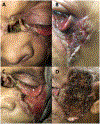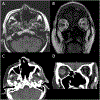Periorbital Pyoderma Gangrenosum Associated With a Cocaine-Induced Midline Destructive Lesion: Case Report and Review of the Literature
- PMID: 36893063
- PMCID: PMC10175135
- DOI: 10.1097/IOP.0000000000002347
Periorbital Pyoderma Gangrenosum Associated With a Cocaine-Induced Midline Destructive Lesion: Case Report and Review of the Literature
Abstract
A 72-year-old woman with a history of chronic cocaine use presented 9 months after a dog bite with a large facial ulceration and absent sinonasal structures. Biopsies were negative for infectious, vasculitic, or neoplastic pathologies. The patient was lost to follow up for 15 months and returned with a significantly larger lesion despite abstinence from cocaine. Additional inflammatory and infectious workup was negative. Intravenous steroids were administered with clinical improvement. Therefore, she was diagnosed with pyoderma gangrenosum and cocaine-induced midline destructive lesion due to cocaine/levamisole. Pyoderma gangrenosum is a rare dermatologic condition that uncommonly involves the eye and ocular adnexa. Diagnosis involves clinical examination, response to steroids, exclusion of infectious or autoimmune conditions, and identifying potential triggers including cocaine/levamisole. This report highlights a rare presentation of periorbital pyoderma gangrenosum causing cicatricial ectropion associated with concomitant cocaine-induced midline destructive lesion and reviews important aspects of clinical manifestations, diagnosis, and management of pyoderma gangrenosum and cocaine/levamisole autoimmune phenomenon.
Copyright © 2023 The American Society of Ophthalmic Plastic and Reconstructive Surgery, Inc.
Conflict of interest statement
Dr. Thaller reports royalties from Thieme and Springer book publishing companies. The other authors have no relevant financial conflicts of interest. The authors alone are responsible for the content and writing of the paper.
Figures




References
Publication types
MeSH terms
Substances
Grants and funding
LinkOut - more resources
Full Text Sources

